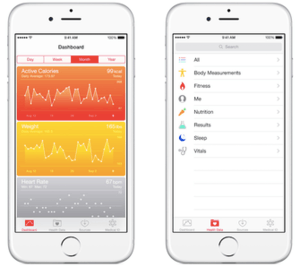Health (software)
|
| |
|
Health app running on an iPhone 6 | |
| Developer(s) | Apple Inc. |
|---|---|
| Initial release | September 17, 2014 |
| Stable release |
10.3.2 (14F89/14F90)
/ May 15, 2017 |
| Operating system | iOS |
| Type | Health informatics, Physical fitness |
| License | Proprietary |
| Website |
www |
Health is an application announced by Apple Inc. at their Worldwide Developers Conference (WWDC) 2014. It is included with iOS 8 or later.
The application is intended to be a personal and central data collection point, for connected third-party electronic accessories and wearable technology, that can directly monitor and analyse an individual's biochemistry and physiology for medical and general fitness purposes.[1]
It displays a dashboard of all the fitness and health data of the user, including the heart rate, calories burned, blood pressure, blood sugar, cholesterol, and other similar functions. Users can also use the Health app to create a Medical ID, an emergency card with important medical details and emergency details. The Medical ID is accessible from within the Health app or from the lock screen [1]
As of March 21, 2016, Apple enhanced this software with various improvements that include a facility to discover other compatible applications on Apple's app store. For example, for blood pressure this includes Health Mate, Qardio Heart health, Web MD, and Pacer. To discover and access these applications place the main function from Apples health app on the dashboard, tap it, and page up.
Although the application is available in iOS 8 and later, it is currently only available on iPhone and iPod Touch, but not on iPad.
iOS 10 users residing in the United States will be able to sign up to be an organ, eye, and tissue donor in the Apple Health app. All registrations submitted through the Health app will be sent directly to the National Donate Life Registry, which is operated by Donate Life America.[2]
HealthKit
HealthKit is the accompanying developer application programming interface (API) included in the iOS SDK (Software Development Kit) for the Mac. It is used by software developers to design applications that have extensibility and that can interact with the Health application on iOS.
The API allows other applications with the user's permission, to access health data. For example, a blood pressure application would share information with a doctor, or a nutrition application could inform a fitness application how many calories a user consumes each day.
Upon announcement, a number of industry companies quickly announced their support for HealthKit, some of these included EPIC, Mayo Clinic, Medopad, Jawbone UP, and RunKeeper.
Craig Federighi, Apple’s senior vice president of Software Engineering, announced in June 2015 a series of new updates to be implemented for the HealthKit API platform. Updates announced in June 2015 include: tracking how much water a user drinks, how much time a user spends sitting, UV exposure, and reproductive health.[3]
2014 launch
Shortly after the release of iOS 8 on September 17, 2014, Apple removed all HealthKit-compatible apps from its App Store to fix a bug causing cellular and Touch ID issues, and then re-released Healthkit, with the release of iOS 8.0.2, on September 26, 2014.[4] Since the release of iOS 8.0.2 an increasing number of apps with support for HealthKit have become available on the App Store.[5]
Compatible hardware
The following hardware is HealthKit enabled:[6]
Apple
- Devices running iOS 8 or later:
- Apple Watch
Balance
- Balance Bluetooth Blood Pressure Monitor[7]
Garmin
- Garmin VivoSmart
Fitbit
- Fitbit (if used with Wristband Manager App)
Jawbone
- Jawbone UP
Qardio
- QardioArm Blood Pressure Monitor
- QardioBase Wireless Scale & Body Analyzer
Withings
- Withings Scale
- Withings Blood Pressure Monitor
- Withings Pulse Ox
- Withings Aura (Sleep Tracker)
iHealth
- iHealth Scale
- iHealth Blood Pressure Monitor
- iHealth Oximeter
- iHealth Activity Tracker
Reception
Initially, Health was criticized for its lack of compatible third-party applications (at launch), glucose tracking, proper health data explanations, and sluggish app performance.[8][9] Eventually, Apple fixed these issues with a software update.[10]
See also
References
- 1 2 "iOS 8: Health". Apple Inc. June 2, 2014. Retrieved June 27, 2014.
- ↑ Kate Anne (July 6, 2016). "Apple Health app update: register to be an organ donor". topmobiletrends.com. Retrieved July 22, 2016.
- ↑ MCHUGH, MOLLY. "Apple Finally Adds Reproductive Health to HealthKit". Wired. Retrieved June 8, 2015.
- ↑ Mike Beasley (September 26, 2014). "Apple releases iOS 8.0.2 to address cellular and Touch ID issues in previous update". 9to5Mac. Retrieved September 26, 2014.
- ↑ "iOS 9: Health". Apple. Retrieved March 13, 2016.
- ↑ "List of Healthkit Compatible Devices". iSmartLiving.net. Retrieved February 6, 2017.
- ↑ "Greater Goods - RISE | BALANCE | NOURISH | WEIGHTGURUS".
- ↑ Hall, Zac (September 17, 2014). "Apple seemingly removing HealthKit compatible iOS 8 apps from App Store due to issues". 9to5Mac.
- ↑ Hall, Zac (December 18, 2014). "iOS 8.2 brings back blood glucose tracking, explains Health data". 9to5Mac.
- ↑ Viticci, Federico (March 16, 2015). "iOS 8.2 and Health Follow-Up". 9to5Mac.
